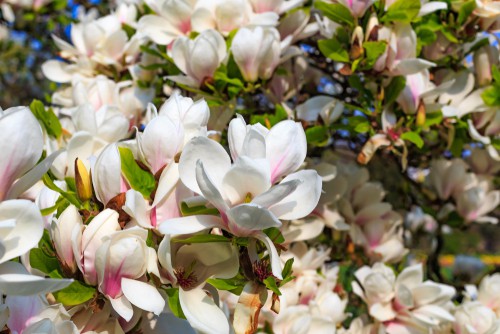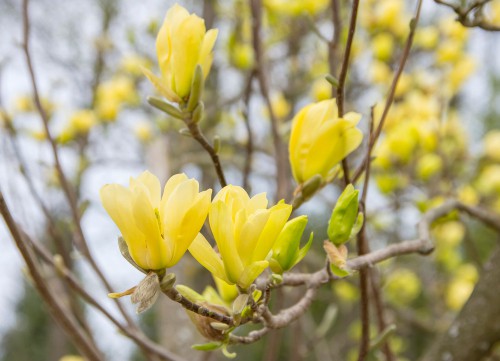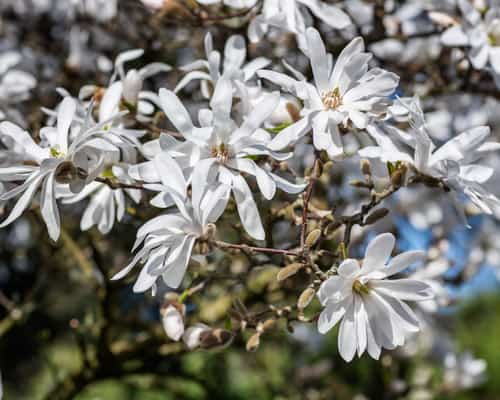Last updated on April 19th, 2022
Our site is reader supported, this means we may earn a small commission from Amazon and other affiliates when you buy through links on our site.
Magnolias are stunning deciduous and evergreen trees that are representative of an ancient species of trees, so the dramatic flowers and fragrant blooms have been appreciated throughout the centuries. Today they remain well known for the large and leathery leaves as well as their beautiful flowers, although sometimes those leaves start to drop and if you have put a lot of effort into maintaining your Magnolia it might be cause for concern.
So why has your Magnolia dropped so many leaves? There are a handful of reasons that could be causing this problem. Firstly, you have to consider the type of tree you have and whether by design it will not really lose its leaves. You also need to consider environmental factors, things as the soil conditions, watering habits, whether the leaves are being dropped right before your Magnolia flowers, or whether they are being dropped throughout the spring.
Type of Magnolia
There are different species of Magnolias, some of which come in the form of a tree and others that come in the form of a shrub. Magnolias can be evergreen or deciduous, with most of the varieties you plant in your garden in the UK (such as the Stellata or Susan) are deciduous. This means that they drop their leaves every autumn to conserve energy for the upcoming winter months. There are, still, some varieties that are semi-deciduous in which case they might still go into dormancy and drop their leaves out of necessity.

Evergreen is a bit of a misleading term because even evergreen plants have to shed older leaves and needles, the same way you have hair on your head all the time but you still lose hair every day. Healthy trees can regularly drop up to 10% of their existing leaves during a drought as a way to conserve moisture and maintain health. If they didn’t drop these leaves, they would lose too much moisture through transpiration, effectively a breathing process that takes place in the leaves.
Overwatering
If you water your Magnolia too much it can also have a negative result, where you will see a multitude of leaves dropping, and not just the standard 10% that you would see drop during a drought. You need to make sure that you are watering your plant the appropriate amount, which means keeping the soil moist. If you are growing them in pots, make sure it is free-draining soil and that the containers have drainage holes in that cannot get blocked.
Nitrogen
Another issue could be the soil in which your Magnolia is growing. Environmental stresses are usually the result of weather, water, or soil conditions. Magnolias are rather particular about the soil in which they grow and if they don’t get enough nitrogen, they will shed extra leaves. You can try to combat this by putting nitrogen back into the soil with some slow-release fertiliser and verifying whether or not this rectifies the problem.
- Deficiency Treatment: RAW Nitrogen is designed to efficiently treat nitrogen deficiencies, ensuring your plants receive the essential nutrients they need for robust development.
- Vegetative Stage Support: Give your plants the boost they need during the vegetative stage. RAW Nitrogen provides the necessary nitrogen support crucial for healthy leaf and stem development.
- Versatile Use: Whether you're cultivating plants indoors, outdoors, or through hydroponics, RAW Nitrogen is a versatile supplement suitable for various growing environments.
- Increased Plant Growth: Experience accelerated plant growth as RAW Nitrogen stimulates vital processes, contributing to an overall thriving and vigorous garden.
- RAW Nitrogen: 20% Ammonium Nitrogen in water-soluble form. Unlike nitrates or urea, it's versatile, usable at all growth stages. Plants absorb nitrate N and ammonium N; RAW Nitrogen is exclusively Ammonium Nitrogen. Ideal for Nitrogen boost, deficiency treatment, and recipe solutions. Versatile use as a foliar feed and during bloom, providing flexibility not found in Nitrate N-based products.
Environmental Stress
During a drought, in order to conserve moisture your healthy tree can drop a significant portion of its leaves. This is one of a handful of environmental stresses that can result in a lot of leaves falling from your tree. Excess wind storms, severe weather, flooding, all of these can add to extra leaves dropping from your tree. Usually, this doesn’t kill the tree but can hold them back for a while and they usually recover.
Leaf Drop
In the spring, you might notice your Magnolia tree dropping its oldest leaves. You’ll know that it’s dropping older leaves because they turn yellow very suddenly throughout the tree and then drop. They won’t drop all at once, they simply fall during the season. Most of the time these are the larger leaves, just shy of 25cm, and they’re often very strong.
These are not things that you need to be worried about but you should remove them once they fall to keep the area clean. If you choose not to prune your Magnolia early on so that you can maintain an upright shape and you let the lower limbs drape to the ground, they will strategically hide all of these fallen leaves so you won’t see them. This brings with it the benefits of decomposition that add extra protection for the roots and more nutrients into the soil.

Leaf drop before or during flowering
With a Magnolia, you need to understand that it takes quite a bit of energy for your trees to produce flowers, and in some cases that finite amount of energy has to be divided between flowers and leaves in which case, your Magnolia may trade one for the other. In fact, Magnolias are well known for dropping their leaves right before flowering. This is much more noticeable if you have an evergreen Magnolia with large leaves, especially when you consider the mess that is made when they drop.
You need to keep your eyes peeled for when your Magnolia drops its leaves. If you noticed that it regularly drops its leaves right before it flowers, the issue isn’t one that you need to worry about. Rest assured that it will produce new leaves as soon as the flowering process is over.
Compact Soil
If there are other occassions that your Magnolia is dropping its leaves it could be the result of a health problem. It is beneficial to lightly mulch the area directly underneath the Magnolia using pine bark or pine straw to make sure the soil stays loose and aerated. If the soil becomes compacted it reduces the amount of oxygen that gets to the roots and this can cause problems for Magnolias and other trees. Mulching will also keep the weeds at bay, which will also improve the overall appearance of your tree and make sure weeds are not stealing vital nutrients out of the soil.

If you notice your Magnolia tree dropping a lot of leaves, pay attention to when it is dropping them, how many leaves out of the entire tree are being dropped, and what other factors might be happening at the same time that could lead to leaves dropping off the tree.
In most cases you won’t need to do much, other than tidy up the space around your tree, and if the problem is something within your control you can always change how frequently you water, add some nutrients back into the soil, or strategically prune your stunning Magnolia tree.
Last update on 2025-04-04 / Affiliate links / Images from Amazon Product Advertising API



